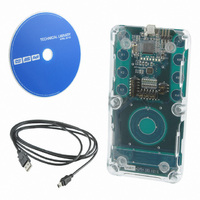ATAVRTS2080A Atmel, ATAVRTS2080A Datasheet - Page 51

ATAVRTS2080A
Manufacturer Part Number
ATAVRTS2080A
Description
KIT QTOUCH W/SW ATMEGA88
Manufacturer
Atmel
Series
QTouch™r
Specifications of ATAVRTS2080A
Sensor Type
Touch, Capacitive
Sensing Range
1 Rotor, 1 Slider, and 2 Buttons/Keys
Interface
Application Programming Interface (API)
Voltage - Supply
1.8 V ~ 5.5 V
Embedded
Yes, MCU, 8-Bit
Utilized Ic / Part
ATmega88
Tool Type
Development Kit
Cpu Core
AVR 8 / 32
Data Bus Width
8 bit
Core Architecture
AVR
Silicon Manufacturer
Atmel
Silicon Core Number
ATmega88, ATmega88A
Silicon Family Name
AVR
Kit Contents
Board, CD
Development Tool Type
Hardware / Software - Eval/Demo Board
Rohs Compliant
Yes
Lead Free Status / RoHS Status
Lead free / RoHS Compliant
Sensitivity
-
Lead Free Status / Rohs Status
Details
- Current page: 51 of 178
- Download datasheet (4Mb)
Given the above requirements for the applications, the first step is to select the right library
variant required.
Step 1: Selecting the right library variant
Referring to the library selection guide, we see that there are a few variants of libraries supported
for ATmega1280. Since the application requires 12 channels and rotor slider support, one has to
select a library variant which supports at least 12 channels or more along with 3 Rotors/Sliders.
Hence we select the 12 channel library variant for GCC complier which supports the required
number of sensors/channels. This works out to be libavr51g1_12qt_k_3rs.a
Step 2: Defining the constants / symbols in the project space
In the host application file (say main.c), define the following constants and symbols
Step 3: Usage of library API’s
Now, you can use the touch API’s to create, initialize and perform touch sensing. Please refer to
the sample applications in section 5.6.11.2 for reference. These sample applications illustrate the
usage of the API’s and the sequence of operation.
Step 4: Adding necessary source files for compilation
The source files needed for compiling your application along with the touch library are
touch_api.h, touch_qt_config.h and qt_asm_tiny_mega.S.
5.6.10.2.2 Example for ATSAM
The example below will explain in detail the steps to follow for library selection.
Criteria
Microcontroller
IDE and compiler tool chain used
Number
application
Rotors and sliders required
Number of Rotors and Sliders required
Number of Channels required for the
application ( should be the sum of all
channels required for all the keys ,rotors
and sliders used in the design )
Charge cycle time required for the design
#define QTOUCH_
#define QT_NUM_CHANNELS
#define SNSK1
#define SNS1
#define SNSK2
#define SNS2
#define QT_DELAY_CYCLES
#define _POWER_OPTIMIZATION_
#define _SNS1_SNSK1_SAME_PORT_
NOTE: The above definitions are available in touch_qt_config.h file. Alternatively, you
can define these in your IDE’s project options or have them defined in a separate header
file. For IAR IDE, all these symbols have to defined for both compiler and assembler
preprocessor defines separately.
of
Keys
required
for
the
Selection
AT91SAM3S
IAR Workbench and GNU compiler
3
Yes
3
12
5 cycles
12
A
A
B
C
1
1
Notes
The
variant of the libraries for
the device selected needs
to be used.
Each
QTouch
channel
Each rotor / slider will
require 3 channels.
3 Keys + ( 3 rotors x 3
channels per rotor/slider )
Assuming the device is
configured with a clock
12 channels
key
GCC
requires
acquisition
compiled
51
1
Related parts for ATAVRTS2080A
Image
Part Number
Description
Manufacturer
Datasheet
Request
R

Part Number:
Description:
DEV KIT FOR AVR/AVR32
Manufacturer:
Atmel
Datasheet:

Part Number:
Description:
INTERVAL AND WIPE/WASH WIPER CONTROL IC WITH DELAY
Manufacturer:
ATMEL Corporation
Datasheet:

Part Number:
Description:
Low-Voltage Voice-Switched IC for Hands-Free Operation
Manufacturer:
ATMEL Corporation
Datasheet:

Part Number:
Description:
MONOLITHIC INTEGRATED FEATUREPHONE CIRCUIT
Manufacturer:
ATMEL Corporation
Datasheet:

Part Number:
Description:
AM-FM Receiver IC U4255BM-M
Manufacturer:
ATMEL Corporation
Datasheet:

Part Number:
Description:
Monolithic Integrated Feature Phone Circuit
Manufacturer:
ATMEL Corporation
Datasheet:

Part Number:
Description:
Multistandard Video-IF and Quasi Parallel Sound Processing
Manufacturer:
ATMEL Corporation
Datasheet:

Part Number:
Description:
High-performance EE PLD
Manufacturer:
ATMEL Corporation
Datasheet:

Part Number:
Description:
8-bit Flash Microcontroller
Manufacturer:
ATMEL Corporation
Datasheet:

Part Number:
Description:
2-Wire Serial EEPROM
Manufacturer:
ATMEL Corporation
Datasheet:












